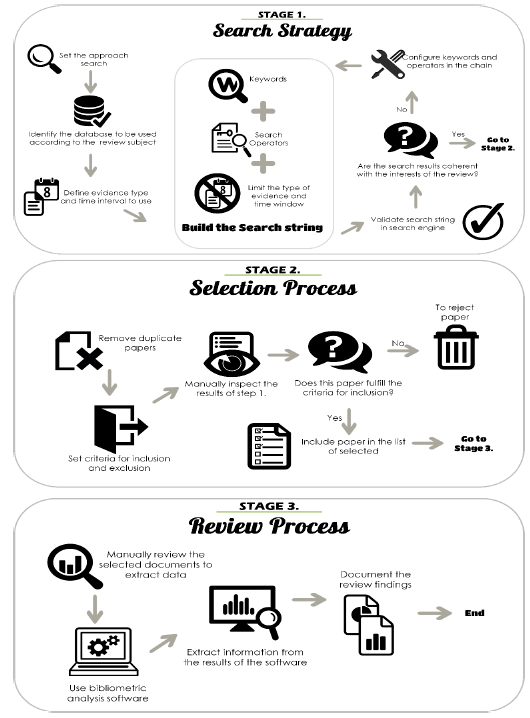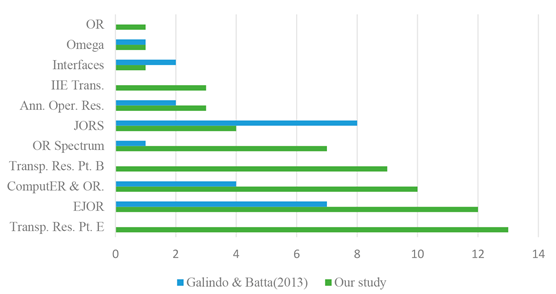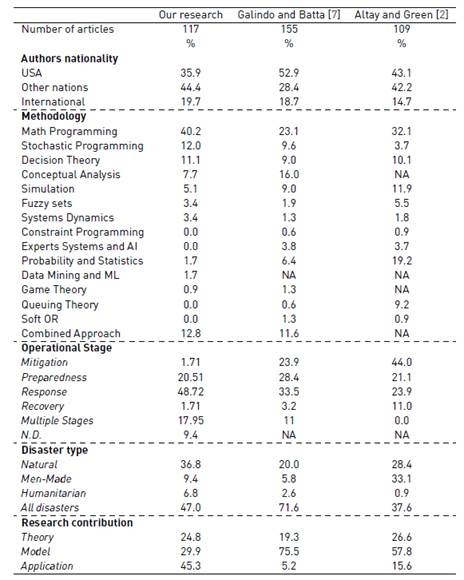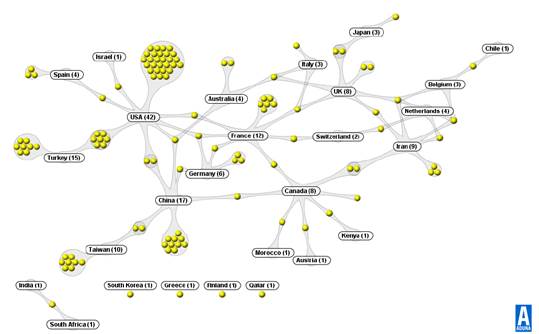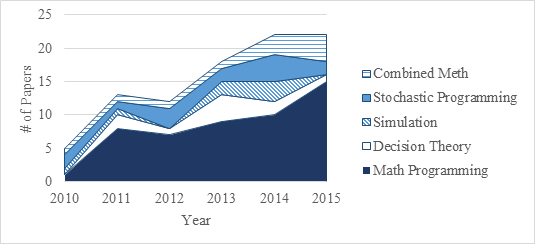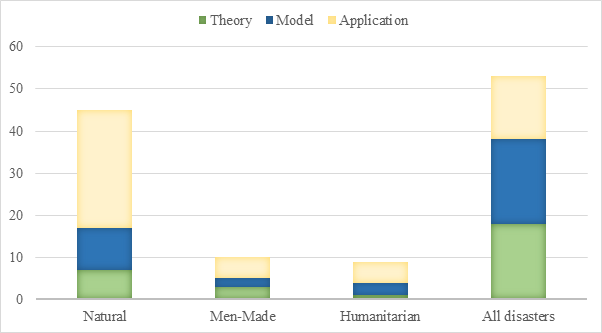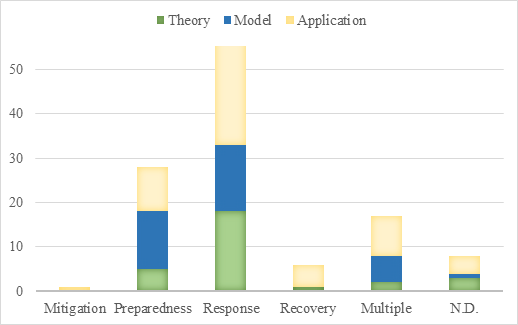1. Introduction
In recent years, natural disasters have affected an important portion of the population causing a tremendous amount of economic and human losses. In 2017 alone, 318 natural disasters affected 122 countries, causing 9503 human deaths, 96 million victims, and estimated damages of US$314 billion [1]. Although progress has been made in understanding disasters, some societies have a limited capacity to tackle their massive destructive effects. Therefore, it is necessary not only to act on the risk elements of a disaster but also to address the management of response and recovery operations after a disaster.
Disaster management corresponds to the activities carried out before, during and after a disaster, which aim to avoid human losses and economic impacts, as well as go back to normal [2]. In this sense, disaster operations management (DOM) provides tools to prepare for disasters, to respond to them, and to provide support and rebuild the society after them.
Since the mid-eighties, the components of an emergency management program have been classified into four stages: mitigation, preparedness, response, and recovery [3]. The mitigation stage involves all the activities that reduce the degree of long-term risk to human life and property from natural and man-made hazards. The preparedness stage aims to develop operational capabilities for responding to a disaster. The response stage includes the actions that are taken immediately before, during or right after a disaster in order to save lives, reduce property damage, or recover easier. Finally, the recovery stage includes all the short-term activities that restore vital life-support systems to minimum operating standards and long-term activities that return life to normalcy. Based on their objectives, uncertainty and duration, the first two stages can be considered as pre-disaster operations, while the last two can be classified as post disaster humanitarian logistics [4, 5]. A discussion on the stages of disaster management can be found in the work of [6].
Because of the unpredictability of the impacts of disasters, an effective scheme for operations management has been of prime importance in the stages of disaster management. In contrast to a conventional situation of operations management in a company, most decisions in a disaster scenario must be made in advance or shortly after an event occurs, which cause difficulties in decision-making. Therefore, advanced decision-making techniques have played a key role in humanitarian logistic systems. Among the diverse techniques available, Operations Research and Management Science -OR/MS- provide a set of analytical tools that enable the decision-making processes in the DOM context and facilitate the performance improvement of the disaster response systems.
Since different contributions to the field of DOM have been made from the OR/MS discipline, it is useful and necessary to continue exploring the research in this topic. This paper presents the results of a systematic literature review of OR/MS applications in the field of DOM with the aim of identifying new research avenues and challenges, in line with the pioneering works of [2] and [7]. The analysis includes 117 journal articles published between 2010 and 2015, providing temporal continuity to the previously conducted reviews on this topic. Within this period, some disasters of considerable impact occurred in different parts of the world, and received attention from the DOM community, such as the earthquake and tsunami in Japan in 2011, the flooding in China and Pakistan in 2010, and the earthquakes in Haiti and Chile in the same year.
To develop this review, we consider the classification scheme used by [2] and later by [7], excluding the dimension of the classification designed by [8]. The results of every dimension of the classification scheme are obtained by using the bibliometric software Vantage Point. The analysis of the literature shows that some research opportunities identified by [7] have been addressed in the last six years; however, there are still some gaps identified by [2] unexplored. We also identify emerging OR/MS techniques and applications to the field of DOM, and discuss future research directions and challenges that remain unaddressed.
The rest of this paper is organized as follows: In item 1.1 a review of the background and previous studies on the subject is presented. Section 2 presents the methodology for the systematic review, including the search and selection process, as well as the scope of the analysis. Section 3 presents the main results of the analysis based on the classification presented by Galindo and Batta [7]. Section 4 presents a classification of the surveyed papers according to the main problems studied by OR/MS field in DOM. Section 5 proposes future research avenues in this field. Finally, section 6 presents the conclusions and observations of this study.
1.1 Background
In recent years, academic and practitioners in the field of OR/MS have increased their attention in developing decision making tools with the aim of responding to different types of disasters with effective decisions. This interest is related not only to the impact that disaster management has in any society, but also to the adaptability of the OR/MS models to the different operations in disaster management. Because of this increasingly interest, a considerable amount of research has been undertaken on this field during the last thirty-six years or so. Remarkably, the last six years have been a dramatic increase on the interest from the OR/MS community to address the DOM research avenues.
[2] were the first authors that conducted a literature review on the OR/MS in the DOM context, in order to give a starting point for interested researchers in disaster operations by identifying research avenues and discussing relevant topics. Their work encompassed the review of 109 documents published between 1980 and 2004, which were classified according to the OR/MS methodology, the stages of disaster management, the type of disaster, the type of research contribution, among others. This study identified seven areas that should be given priority in subsequent research efforts due to their potential impact on DOM research: multi-agency research, methods, technology, DOM stages, business continuity, infrastructure design, and management engineering.
In this line of work, [7] evaluated how operations research has evolved in terms of DOM and to what extent the gaps identified by [2] had been fully addressed. They reviewed 155 documents published between 2005 and 2010, by using the same classification scheme as in [2]. Their findings pointed out that significant developments had not been made in the field of OR/MS in DOM and that some theoretical gaps previously identified by [2] remained unaddressed. They also evaluated the most frequently assumptions in disaster management and identified new research avenues for DOM.
The reviews of [2] and [7] provided an analysis of the research work on OR/MS applications to the DOM field between 1980 and 2010. They also helped to identify fertile research avenues for this field. Nonetheless, OR/MS community have had an increasingly interest in the DOM field in the last six years, remaining unclear how the research perspectives on this field have evolved. Are there novel research gaps that have been identified during the last six years? Have there been emerging OR/MS applications involving new techniques to answer new questions in DOM?
Other literature reviews on DOM were published after the work of [2]. [9] proposed a framework to distinguish between the actors, the phases and the logistic processes by making a parallel between humanitarian and commercial logistics. [10] conducted a systematic review in disaster management including documents published between 1980 and 2006, with the aim of contributing to the existing knowledge about disaster management, and defining the state of the art of the discipline at that time. [11] focused on the Operation Research -OR- literature applied to emergency response between the years 1965 and 2007. They also offered an explanation of some existing paradoxical challenges in the DOM field from the OR perspective. [12] analyzed the challenges in humanitarian relief chains, described the current and emerging practices of disaster relief, and evaluated the adaptability of the humanitarian relief environments.
In [13] categorized the research papers in humanitarian logistics considering the theory of constraints and the literature of information systems management. Later, [14] focused on the literature of vehicle routing problems to deliver goods and services in the regions affected by a disaster. They classified the research work into four categories: assignment policies, evaluation of needs, demand and supply uncertainty, and vehicles and routes characteristics. [15] classified the literature of emergency logistics in three types of problems: service location, aid distribution, and victims transportation. [16] proposed a framework that should help decision-makers in the field of humanitarian logistics to find, compare, and apply OR models considering the type of decisions, the decision criteria and metrics, as well as the methodology and assumptions. [17] centered their discussion in OR models with some stochastic component applied to DOM, along with an analysis of the techniques used to model and solve them. [18] analyzed the research progress made on evolutionary algorithms applied to relief operations.
2. Scope and methodology
The methodology to carry out this study is adapted from the guidelines proposed by [19] and [20]. It has three components: a search strategy, a selection process, and a review process [Figure 1]. This methodology can be summarized as follows:
-
Objectives and general needs of the review. The scope of this study is the OR/MS in DOM, therefore, it was limited to the definitions of OR/MS, disasters and DOM. Considering these definitions, all the types of disasters were considered according to the International Federation of Red Cross and Red Crescent Societies (IFRC). For more information, the interested reader can refer to www.ifrc.org.
-
Electronic search. A preliminary search allowed us to identify that the journals with the highest impact in the research area of this study are found in the ISI’s Web of Science Core collection, so this database was taken as the main source. A search of keywords was conducted in the main collection of the ISI Web of Science based on the search process of [2] and [7]. We used the following keywords: "disaster management", "emergency logistics", "humanitarian logistics", "relief operations", "disaster relief", "disaster response", "humanitarian supply chain", "catastrophe" and their extensions. These descriptors were searched on the title, abstract and keywords. The research work related with the fields of medicine, health, politics, geophysics, biology, psychology, social sciences, infrastructure, and electronics were filtered through pertinent boolean operators.
-
Application of inclusion and exclusion criteria. Inclusion and exclusion criteria were defined to determine the documents aligned to this study. A document was included if it was an English written journal article published between 2010 and 2015, whose content was related with the use of any OR/MS technique in the study, comprehension, or solution of some operation in the DOM. The results were filtered by making use of the OR/MS category at the database. We did not include books, book chapters, and conference proceedings in the search process. In addition, publications that address emergencies in commercial supply chains were excluded. With the aim of reducing the number of papers, a manual exploration of the documents was performed by inspecting the titles and abstracts. We used the software Vantage Point to eliminated duplicates.
-
Data Analysis. After conducting the previous steps, a total of 117 articles were chosen for the review process. The results of the bibliographic analysis were generated by using the software Vantage Point 9.0, Search Technology, Inc.
There is certain subjectivity in the selection of the literature to carry out the analysis. However, this paper is not an exhaustive bibliographical study but it is the result of a systematic and scientific review methodology in the specific field of OR/MS in DOM.
3. Research perspectives of OR/MS in DOM
A total of 117 journal articles were included in this review, including 84 references that were published in OR/MS mainstream scientific journals ranked in Q1 and Q2 according to SCImago Journal Rank (SJR, 2015). Some of these journals include Journal of Operations Management, Omega, Operations Research, Transportation Research-Part B, International Journal of Production Economics, Production and Operations Management, and Computers and Operations Research.
A comparison of the number of papers included in this study and published in OR/MS journals with these reported by [7], revealed that most papers in the DOM area [Figure 2] for both time frames were published in Computers & Operations Research, Transportation Research-Part E, and the European Journal of Operational Research (EJOR). Nonetheless, a remarkable increase in the number of DOM publications was also found in journals such as OR Spektrum and Computers and Operations Research, with respect to the findings of [7]. This might have occurred because of special issues in Optimization of Disaster Relief and Emergency Management in 2011 and 2014, respectively. In the last six years, the topics related with transportation and logistics in DOM have received greater attention, with a significant number of contributions in specialized journals including evacuation research, aid distribution, and location of support facilities. Some scientific journals that published papers on this topic during the observed time frame, which were not reported by [7], were Transportation Research Part E and Part B.
The remaining 33 articles were published in journals of engineering, safety and reliability, and mathematical applications. Some remarking journals included Safety Science, IIE Transactions, and Expert Systems with Applications.
Table 1 presents a synthesis of the papers classification by categories, which was carried out according to the OR/MS methodology, the type of disaster, the phase in the disaster cycle, and the type of contribution.
3.1 Authors affiliation
The category of authors nationality [Table 1] indicates the affiliation of them. Likewise, the points represented in Figure 3 correspond to the total number of articles per country, where the points that connect different countries correspond to papers in co-authorship. In this sense, we observed that most research papers were produced in the USA and a significant amount of them were published in co-authorship with Turkish researchers. West Europe and Asia were regions with significant contributions, where France and China were the corresponding leaders. In line with the results of [7], we found that contributions from Latin America and Oceania researchers continued to be low during the time frame of this study.
Chile is the only country in Latin America with a contribution to this field during the time frame, however, this study was included in the International category since it was coauthored by researchers from different nationalities [2]. The category International certainly had an increase in the number of publications with respect to the results reported by [7]. Nonetheless, our results suggest that the tendency of working with colleagues of the same nationality has increased which is evident in the category other nations [Figure 3].
3.2 Methodology
The analysis of the selected references showed that mathematical programming continues to be the most popular OR/MS methodology in DOM and it has been mainly used in the response phase [21-24]. Stochastic programming has been one of the most used methodologies as a result of the inherent uncertainty of natural disasters. It has been mainly used to solve problems that consider multiple stages in the cycle of a disaster [25, 26]. For instance, [27] tried to improve the transport network and reduce the expected post-disaster response time through pre-disaster investment decisions using a bi-level stochastic optimization model.
As the Figure 4 shows, the number of research papers on mathematical programming, stochastic programming, and combined methodologies has been a sustained increase. However, a particular trend could not be observed for studies involving simulation and decision theory, which are two useful techniques to support decision-making processes under uncertainty.
We also consider the scientific articles that carried out a conceptual analysis, including literature reviews and other documents where no particular analytical methodology was applied [28, 29].
Data mining and machine learning techniques have received little attention in the DOM field. They were not mentioned in the works of [2] and [7], which covered a period of 30 years. Nonetheless, we found that new OR/MS techniques are contributing to the field of DOM. For example, multiple linear regression, discriminant analysis, classification trees, and other machine learning techniques have been used to support decision making systems in the assessment of a disaster [30].
3.3 Stages in disaster management
Most papers sought to solve problems in the response phase, an ongoing trend since the work of [2]. By contrast, the publications that addressed the mitigation phase decreased considerably with respect to the last two reviews. Other papers were focused on multiple stages of disaster management. In these cases, the authors proposed models to solve problems in pre-disaster (mitigation and preparedness) and post-disaster (response and recovery) operations. For example, [31] studied sheltering network planning and operations for natural disaster preparedness and response. The locations, capacities and resources of the new refuges were decided in the preparedness phase, while the distribution of evacuees and resources to the new refuges are planned to the response phase.
Regarding to the recovery phase, some studies applied OR/MS models to address logistic activities such as the removal of debris [32,33] and the repair of roads [34]. These activities were identified by [2] as research gaps within the recovery phase, and continue being an unexplored research opportunity for OR/MS on DOM. Other publications were not clearly framed in a phase of disaster management, however, these documents presented generalized problems or methods that can be used in any phase of the disaster cycle [35-37].
3.4 Type of disaster
Natural disasters have received more attention in OR/MS, which is evidenced by an increase of research papers in this category regarding to [7]. Particularly, 62% of the studies of natural disasters were applied cases, which can be related with the occurrence of different disruptive events since 2011, including earthquakes, tsunamis, and extreme weather conditions. A significant progress was evidenced in the humanitarian category with respect to the findings of [7] and [2], where OR/MS techniques were applied in studies of epidemics [38] and famines [39]. Other authors carried out studies in international aid entities [40, 41]. Finally, some theoretical articles are grouped in the category All disasters, as they did not specify features of a disaster, and focused on any kind of threat [28, 42-44] [Figure 5].
3.5 Research contribution
Based on the classification proposed by [2], and the definitions of each category presented in [7], the articles are classified into three categories based on their contribution to DOM knowledge: Theory, Model, and Application.
Articles that develop reflections on a particular topic, test hypotheses, present a framework, study the behavior of a system, define principles or taxonomies, or review literature, are classified in the Theory category. The Model category includes publications that address analytical models to solve or analyze a problem. Finally, articles that develop a computational tool or prototype (including Decision Support Systems -DSS-) are included in the Application category.
In comparison with the results found in [7], the proportion of articles with applications has increased and the proportion of studies focused on models have decreased. We consider that these variations are related to the need to develop agile and efficient tools that support the decision-making process in the field of DOM, specifically, the development of applications for solving the analytical models that have been recently formulated in this area. As shown in Figure 6, most of contributions in the different phases of the disaster cycle have been in the Application category, mainly in the response and preparedness phases. The theoretical articles have been mainly in the response phase, while the articles that refer to multiple stages are concentrated in the Model category.
4. Concentration areas in DOM research
The research work in DOM has been focused on three phases in the disaster cycle: the preparedness (pre-disaster), the response, and the recovery (post-disaster). Most operations of each phase have been studied from the OR/MS field to improve their understanding and development. In this sense, we divided the literature in five categories based on the main problems identified in the DOM research work: (1) location and network design, (2) transportation, (3) location and transportation, (4) inventory, and (5) other less popular contributions in DOM [Table 2].
One of the main operations in disaster management is the network design, which includes the location of any facility inside the humanitarian logistic network. For this operation, the research work has been focused on the response phase, where mathematical programming is the most used method. Location has been modeled mainly through the Facility Location Problem (FLP) and mono-objective covering models during a single period. Some multi-objective studies seeking the minimization of costs, unsatisfied demand or time were first presented in the work of [2], and were complemented by the works of [21, 49, 33]. Other contributions of network design used stochastic models to address the uncertainty in the estimation of disaster impacts. This uncertainty is not only associated with the demand, but also with the supplies, the cost of acquisition, and transportation, among other characteristics of the disaster [27, 48, 49, 53, 57].
The transportation category includes the distribution of supplies, the transportation of victims, the evacuation of the affected population, and the search and rescue operations (S&RO). Most operations were modeled as a variant of the Vehicle Routing Problem (VRP) or as a case of last mile distribution. To solve the transportation problem, a wide variety of integer programming models has been proposed, including Mixed Integer Programming [75, 84, 99]. Other studies used heuristic and metaheuristic solution schemes, such as genetic algorithms [76, 78] and local search [89]. A diverse set of optimization criteria has been considered in this research field, including efficiency, effectiveness, and equity [135].
Our literature review revealed that most studies in the transportation category has been focused on efficiency (costs) and effectiveness (response time, travel distance, coverage, reliability and safety) criteria. Equity criteria, which are related to justice, have received little attention because it remains unclear how to model them [44]. According to [135], the simplest way to address equity is to consider the worst case value of a measure of disutility over all groups of people as an objective function. For example, the objective of a distribution problem is defined as a function of the worst travel distance to the nearest depot. So, the final result is a little value when there is inequity among the attention levels. Other equity criteria were also identified in the literature review, including the demand satisfaction, the number of survivors or injured people [24,70,80,84], and the social or psychological costs. For instance, a recent study proposed a method for designing a centralized emergency supply network to minimize the travel distance, the operational cost, and psychological cost [59] [79] proposed a multi-objective linear programming model for post-disaster debris reverse logistics, where the cost function is the psychological stress experienced by local residents while they are waiting for medical treatment and debris removal. This cost function must be minimized along with the environmental and operational risks.
Category 3 includes contributions that address problems of location and transportation as a whole. In this group, the Location Routing Problem [100], and its variants, the Capacitated Location Routing Problem [102], the Open Location Routing Problem [99], and the Warehouse Location Routing Problem [98] have been the most used. The Covering Tour Problem [22] and the Location-Transportation models [97] have also been used in the DOM context. Most studies in this category were multi-criteria including classic measures of effectiveness such as time, cost, and coverage.
On the other hand, planning (pre-location) and inventory stgrategies are grouped in the category Inventory. Around half of the contributions in this category dealt with goods pre-location, where the total cost minimization is the common objective. Different methodologies have been used to address the inventory operations, including stochastic programming [25, 26, 104, 105, 111], mathematical programming [103, 106, 108, 110], and systems dynamics [107, 109].
Other papers addressed less popular research problems that represent a valuable contribution to the OR/MS applications in DOM. Some authors were focused on operations of the recovery phase, such as the management of debris (removal, disposition and recycling), the assessment of damages [116], and the restoration of roads [34]. Despite the importance of post-disaster debris management, the studies of OR/MS to support the decision-making processes involved were limited. Table 3 provides a synthesis of the papers found in this area.
Finally, some research contributions were focused on information systems [36, 118, 132], decision support systems -DSS- [24, 30], resource programming [38, 128, 129], and improvement of infrastructure [114].
Table 3
Main features of debris management research

[i]Debris Operations-DCl: Debris Clearance, DCo: Debris Collection, DD: Debris Disposal, DR: Debris Recycling. Model- MP: Markov Process, MO: Multi-Objective, LP: Linear Program. Solution Method- Heu: Heuristic, MHeu: Metaheuristic, Ext: Exact methods. Objectives- B: Benefit, C: Cost, R: Risk. Tested: Ac: Academic, CS: Case Study. Constraints- Cap: Capacity.
5. Future research perspectives
This section aims to identify trends and challenges in the research avenues for OR/MS applications in DOM considering three issues indicated in [7]: Actors, Technologies, and the DOM problem. There is no consensus among authors about the operations carried out in each phase of the disaster management cycle. In this sense, an exhaustive study of the operations and their characteristics is still required as a basis for classifying them in the different stages of disaster management cycle.
5.1 Actors
Within the research perspectives suggested by [2], the development of optimal organizational and network structures is proposed to facilitate communication and coordination in disaster resolution. The lack of coordination is one of the main problems in humanitarian operations [12], mainly due to the interaction of different actors in the logistics chain whose objectives may differ. Although [7] identified some publications that address this perspective, including [12, 63, 136], they also highlighted the lack of joint research with humanitarian organizations. Our literature review identifies some publications that fill the gaps evidenced in the previous reviews. [41] described the main characteristics of a humanitarian supply chain, and identify three determining factors for coordination in the humanitarian context: mobilization and allocation, coherence and efficiency, as well as empowerment and best practices. They also developed a quantitative model based on business modeling methodologies, which is applied to the response operations of the IFRC. [108] addressed the operation of the United Nations High Commissioner for Refugees (UNHCR) by developing an inventory model to analyze the interaction between a stockpile and relief operations in a refugee camp, subject to budget constraints. [40] in collaboration with CARE International formulated a pre-positioning model of resources to assess the impact on the average response time in humanitarian emergencies, which was used for the pre-positioning of supplies in three different facilities. Other related articles include [46] and [92].
Even though contributions about this perspective are evidenced, the gap identified in [2] and [7] still need to be filled. In this sense, there is an opportunity in OR/MS to establish the needs of the different actors of the humanitarian supply chain, considering the restrictions in the management of knowledge, financial and human resources, as well as operations.
5.2 Technology
The models developed for humanitarian logistics and their solution methods need to be integrated into information technologies that facilitate their use in practice. However, the use of new adequate technologies is still unexplored in DOM, as it is stated by [7]. An approach to studies on information systems for humanitarian logistics is presented in [5]. Despite attempts to integrate information system in humanitarian logistics models have been made, the use of advanced technologies is not common [131]. On the one hand, the systems already in use, which are centered in information management, have not integrated optimization tools. For example, [137] compared five professional software for humanitarian logistics -SUMA, LSS, HELIOS, LogistiX and Sahana-, which do not consider disaster management operations such as routing or resource scheduling. On the other hand, most information systems do not have a friendly user interface.
The use of information technologies in humanitarian logistics such as Radio Frequency Identification -RFID- and Geographic Information Systems -GIS- are identified in [131]. Information technologies have the potential to link professionals and researchers in humanitarian logistics, as well as connect different phases of the disaster cycle. Therefore, their application remains an interesting topic to explore in order to consolidate more holistic systems that integrate different phases of the disaster cycle as well as different decisions.
5.3 Solving DOM problems
Identification and definition of DOM problems
[2] and [7] identified a lack of research in recovery-related problems after disaster, however, we found some studies addressing this gap. Operation such debris management [32, 33, 138], road repair, and damage assessment were identified in some contributions. Nevertheless, there are still many operations of this phase that offer opportunities for research, such as the recovery planning, the restoration of vital systems (power, water, and gas), and the economic recovery or housing-related issues after the disaster. In this sense, it is important to identify the operational characteristics of the recovery activities that can be modeled through OR/MS methods in order to develop new research in this phase. In large scale disasters, different international aid organizations offer their services in the response and recovery phases by distributing goods and equipment, but the provision of these services can be affected by conflict of interests when arriving to the disaster site [12]. Therefore, there is a need for addressing the integration of international aid operations with local response plans. Furthermore, recovery planning must be multi-agent so that the organizations involved work on common objectives. Finally, the recovery models must include the financial flows.
The transportation-related problems are common in every phase of the disaster cycle and capture the inherent complexity of the disaster environment. The transportation mode used in the models is a relevant topic to be addressed. Both the physical routes among the entities and the flow of aid resources through air, sea and land transportations modes required to be considered in more realistic scenarios [35]. However, the research contributions have been focused on fleets of land transport vehicles and there are few papers dealing with other transportation modes. The problem objectives have been more centered in speed and demand satisfaction than in operational costs. In this sense, the proper selection of the transportation mode must consider the geographic characteristics of the zone and the dispersion of the population. Contributions based on air transportation considered mainly the use of helicopters [89, 110, 139] while those based on multi-modal transportation proposed different types of vehicles and goods [28, 91]. Future research work should include other modes of transportation such as maritime and aerial, and consider not only the costs but also the speed and reliability of the delivery.
Recently, the use of drones or unmanned aerial vehicles -UAV- is an option to solve last mile distribution problems in isolated places when the use of other vehicles is expensive in relation to the amount of goods to be distributed, the travel distance, or the landing conditions. [140] proposed a model that seeks to minimize the overall cost of the system by establishing the optimal location of distribution centers, their inventory levels and service regions, and routing drones to supply emergency items. The authors calculated the transportation cost by taking into account different factors of routing, including climbing, hovering, descending, turning, acceleration and constant speed cost. Other studies in OR/MS that implement drones as a transportation mode are presented in [140-142]. [143] suggested that drones could be used to create maps of affected areas, to know the current state of the roads, and to identify critical points where rescue teams have a greater chance of finding victims. The use of drones is an opportunity in humanitarian logistics not only for the aid distribution but also for obtaining information about disaster areas. Therefore, more research from OR/MS field is still required.
On the other hand, the flow of heterogeneous goods, equipment, and donations to the disaster zone is called material convergence, which ranges from materials of critical importance to the response, to the flow of low turnover supplies. The convergence of materials represents a major problem in humanitarian logistics due to the conglomeration of unhelpful goods in the affected areas as mentioned by [144]. These supplies cause clogged supply chains and resource consumption in their management. This term is not mentioned in previous literature reviews [2, 7], and there is little research on this subject. [145] provided a comprehensive literature review on the problems related to material convergence. [146] conducted interviews to identify the impact of material convergence on the Colorado floods in 2013, and discussed practices and methods to reduce it. The material convergence is one of the six key areas for improving humanitarian logistics and is a variant of commercial logistics. Although this problem has been identified in various disasters, it has not been addressed in the DOM field.
Recently, different authors have incorporated humanitarian objectives in their research. [147] used the social cost as an objective function for humanitarian logistic models, defining it as the sum of logistic and deprivation costs. The latter corresponded to the economic valuation of human suffering associated with the lack of access to a good or service.
In addition, the maximization of survivors and the minimization of evacuation costs are still challenging issues in the response phase. Only the study of [84] aimed to maximize the number of patients who survive after being injured in a disaster. In the context of survival maximization or victim minimization, is it possible to design a performance measure that allows determining whether the implemented strategies have been successful?, and how can such performance measure be included in a mathematical model of the problem?
Regarding to the ethical factors included in service allocation to disaster victims, [7] mentioned that only equity had been considered in the DOM models [24, 44, 68, 83, 2] stated that there was a lack of research work that deal ethically with the limitations and conflictive advantages of the objective function in the disaster models. Future work could be focused on proposing modeling strategies that compensate the efficiency and the ethical factors such as equity.
Since commercial chains have been widely studied, some findings could be adopted by humanitarian chains, despite they are clearly different [9]. For example, it can be useful to study the adaptability of the disruption models of commercial supply chain in humanitarian chains by considering multiple agents in an integrative way. The coordination of donations also offers research opportunities. On the one hand, the formulation of strategies to control the flow of donated supplies must be addressed, so that the delivery of useless or undesirable items does not occur. On the other hand, the reverse logistics of donations must be considered in the design of humanitarian supply chain.
Finally, business continuity is a critical topic considering that 43% of the companies affected by serious catastrophes never recovered, and around 30% of them failed during the following two years [148]. [7] did not find any paper as an answer to the lack of research in the continuity of business after a disaster, as remarked by Altay and Green. However, the contribution of [133], which is identified in the present study, proposed a framework for business continuity and disaster recovery planning after being disrupted by addressing decision problems at all strategic, tactical, and operational levels. They formulated a multi-objective mixed integer linear programming model with the aim of maximizing recovery point and minimizing recovery time objectives. To address the current challenges of business continuity, we also propose the following questions: how could economic impacts be included in business continuity models?, how do the disruptions in the supply chain affect the cycles of inventory rotation?, and how can resilience functions be incorporated in the current models? Although any approach to the resilience issue was not identified in the two latest literature reviews, we found that [149] proposed a multi-criteria approach to capture the compensations between the sturdiness of a system and its speed of recovery in situations where multiple disaster or emergency events occur. The authors extended the concepts regarding the resilience triangle and multiple criteria into sub-events, with the purpose of providing a quantitative measure of resilience by means of a mathematical model. Likewise, other authors tried to establish resilience functions to disasters from analytical [150] and quantitative approaches [151].
Validity of assumptions
As identified in [7], the construction of real assumptions about the uncertainty of DOM problems remains a challenge. The authors presented a summary of the main assumptions in DOM problems, classifying them into three categories: reasonable, limited, and unreal. Likewise, they mentioned the value of incorporating the coverage probability based on the reliability of the infrastructure.
Some authors addressed conditions that are more realistic by including performance measures related to infrastructure. [24] comprised the reliability and safety of operating routes by defining reliability as the probability of crossing an arch completely, and safety as the probability that a vehicle be assaulted when traveling through an arch. The estimation of parameters requires stochastic and analytical models, as well as the incorporation of new techniques such as machine learning. By analyzing the EM-DAT disaster database and applying machine learning techniques, [30] calculated the values of different variables (e.g. number of deaths) based on the magnitude of an earthquake and the human development index of the region. The use of historical data in the construction of variables for logistic models is fundamental.
Many operations have been modeled in the different phases of the disaster cycle; however, most of the models have not represented realistic conditions. For example, many location-allocation problems of the preparedness phase have been based on static data of the population as a parameter of demand. According to [152], the world proportion of urban population is expected to increase from 54% to 66% by 2050. This phenomenon will produce changes in the demand nodes because of overpopulation and migration inside the cities. In this sense, the consideration of population dynamics could be useful in the operations of disaster preparedness including resource allocation, location-assignment, and inventories. [7] also pointed out the unreal data used in the DOM problems, which include static parameters in travel time, costs and demand.
Methodologies
Since the research of [7], new methodologies of OR/MS have been used to solve DOM problems, including data mining and machine learning techniques. These techniques are centered in analyzing large data sets and their applications in the DOM field have been mainly focused on DSS. Modeling uncertainty in disaster management remains a challenge. The use of either stochastic or fuzzy programming is a promising way to include the uncertainty in the model parameters. Contributions from stochastic programming have included not only the uncertainty in demand but also the disaster characteristics among the stochastic parameters. For its part, fuzzy programming is still little used.
Applying the solution
The gap between theory and practice manifested in [2] becomes smaller because of the increase of case studies. Many researchers applied their models to real disasters despite data limitations, which maintain unreal assumptions or the use of simulated data. Some case studies found in this review are those presented in [33, 45,48].
Historical data or information systems in vulnerable regions are required to collect information for the models so that assumptions are diminished.
6. Conclusions
This paper presents a literature review of OR/MS in DOM that complements the pioneering works of [2] and [7]. Our classification scheme was similar to the proposal of [7], by comparing our findings with those reported in previous reviews. Despite a significant portion of the findings of [2] still remains, new challenges of growing interest have emerged, and some gaps have been addressed. This study provides a classification of the surveyed literature according to the main problems addressed by the OR/MS in DOM, and open new avenues for future research. As expected from the classification, the transportation problems have received most attention from the OR/MS community in the DOM field. This can be due to transportation operations are in all the stages of the disaster management cycle. Furthermore, as stated by [7], the OR/MS research in DOM have been concentrated in a few areas of the response phase (e.g. location-allocation, supply chain management, evacuation and distribution). By contrast, operations in the mitigation phase such as risk assessment and emergency control measures have been less studied. The challenges for the academic community are still associated to the proper modeling of the disaster uncertainty.
Among the main avenues for the future research, we suggest to explore the recovery operations, to increase the research efforts in the area of business continuity area, incorporate humanitarian goals in the models, study the reverse logistics in the supply of donations, integrate robust disaster models with the current technologies, and measure the recovery capacity. We also suggest to continue the development of applied contributions in real scenarios of DOM problems, focusing mainly on developing countries where the degree of vulnerability is higher and the resources are scarce.
Disasters are an ongoing threat for the world, and therefore require to be studied so that their effects are mitigated. OR/MS methods have been used to solve DOM problems and facilitate decision-making processes. The OR/MS research in DOM has evolved since the work of Altay and Green [2]. Theoretically, different optimization models have been studied, including a wide variety of logistic problems, objectives and constraints. From a practical perspective, the researchers have made efforts to build more realistic solutions, and to use case studies. There is still a long way to go by academic community, so the findings and suggestions presented in this paper can contribute to develop OR/MS research in DOM and to fill the gaps that remain unaddressed.
